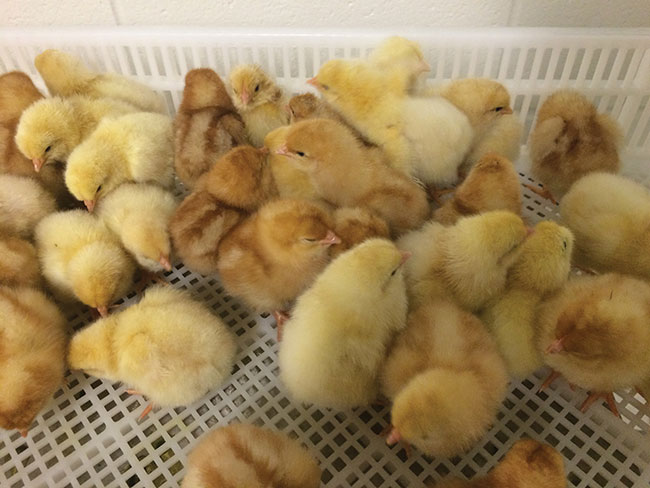
Lighting Research: Hatching a better bird
By Lilian Schaer
Features HealthResearchers find adding light to incubation has positive effects.
 Researchers studied the impact providing lighting during incubation had on the hatch, post-hatch and egg production performance of laying hens.
Photo: Bruce Rathgeber, Dalhousie University
Researchers studied the impact providing lighting during incubation had on the hatch, post-hatch and egg production performance of laying hens.
Photo: Bruce Rathgeber, Dalhousie University Adding light might be the key to more robust chicks that are ideal for antibiotic-free production.
Researchers at Dalhousie University and the University of Saskatchewan (U of S) found that providing lighting during incubation positively affects the hatch, post-hatch and egg production performance of laying hens. More specifically, chicks incubated with red LED light had improved navel health, early body weight gain and egg production without any negative impacts on the eggs they ended up laying as adult birds.
“Historically, we would give weak chicks an antibiotic to get them through the first few days,” explains Bruce Rathgeber of the Department of Animal Science and Aquaculture at Dalhousie. “But, if we can improve their early feeding behaviour, we could get them through those first few days without antibiotics.”
The study, which Rathgeber conducted in collaboration with Karen Schwean-Lardner of the Department of Animal and Poultry Science at U of S, included two incubation trials where eggs were incubated for three weeks using different colours of LED lights and varying amounts of darkness and light.
Incubation trials
In the first trial, 2,400 eggs were incubated under four conditions: 24 hours of darkness; 12 hours of darkness and 12 hours of white LED; 12 hours of darkness and 12 hours of red LED; and 12 hours of darkness and 12 hours of red LED for the first 18 days followed by 24 hours of darkness during the last three days before birds are hatched.
The second trial included 1,280 eggs that were also incubated in four different ways: 24 hours of darkness; 12 hours of darkness and 12 hours of red LED; 12 hours of darkness and 12 hours of blue LED; and 12 hours of darkness and 12 hours of white LED.
In both trials, chicks went into a conventional housing system after hatch. Chicks from the first trial were housed in groups of eight and chicks from the second were housed in groups of six.
Overall, chicks incubated with red light in trial two hatched four hours sooner than those under white light, and six hours sooner than those incubated in blue light and those that received no light at all. They also had the healthiest navels, making them better able to withstand the threat of infection.
In trial one, chicks incubated with red light gained the most weight as a percentage of their original weight. What’s more, they produced an average of 27.6 eggs during their first 47 days of egg laying, compared to only 25.1 eggs from those hens that had been incubated with white light.
None of the lighting conditions resulted in any noticeable impact on egg quality.
The current industry standard for incubation in commercial hatcheries is one without any light, so moving towards including light into the incubation process would not be without cost to the hatcheries.
“There is a cost for putting light fixtures in, but we work with LEDs where the cost of operating is very small – and the cost of fixtures is coming down in price,” Rathgeber says.
Behaviour after hatch
Schwean-Lardner’s work involved evaluating chick behaviour after hatch under different lighting wavelengths. She observed no behavioural differences after hatch as a response to the incubation light colours, but chicks that were subsequently housed under a darkness-light cycle were more active than those in constant or near constant light.
“Traditionally, producers use constant or near-constant lighting because the thought was that this lets birds see the barn and find water and feed,” she says. “But, a light-dark cycle actually made the chicks more active.”
Schwean-Lardner and her graduate student, Celma Eliete Ferreira dos Santos, completed a small subsequent study at U of S where they conducted chick quality assessments and watched bird behaviour. They did so to evaluate the influence of various light-dark cycle lengths in the incubator and hatcher.
“We found chicks incubated on an 18-hour light, six-hour darkness cycle started to hatch considerably sooner than birds with no light – so potentially, a shorter hatch period could reduce the incubation cycle at the hatchery,” she says, adding they noted no differences in post-hatch chick quality or behaviour.
Many other factors besides light can influence how chicks respond though. The trials were also relatively small. Thus, both Rathgeber and Schwean-Lardner caution that more research is warranted to confirm the outcomes and explore further impacts on bird behaviour.
This collaborative project was funded by Egg Farmers of Canada, Egg Farmers of New Brunswick, Egg Farmers of Nova Scotia, Egg Farmers of Prince Edward Island, Agriculture and Agri-Food Canada through Growing Forward II, and Nova Scotia Department of Agriculture through Research Acceleration.
Print this page